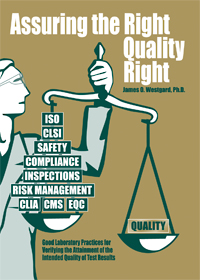Advanced Quality Management / Six Sigma
Quality Goals, Systems, and Specifications
When it comes to Quality, where are we now? Dr. Westgard reviews the evolution of quality control, quality design, as well as the development of tools to help plan quality. It helps to understand how we arrived at Quality Systems - and where we should plan to go in the future.
- Historical Perspective on Quality Control and Quality Goals
- Systems Perspective on Quality Goals
- A System of Quality Goals would Recognize that...
- Translating Quality Goals into Operating Specifications
- Sources of Recommendations for Quality Goals
- What's the Point?
- References
Historical Perspective on Quality Control and Quality Goals
Statistical quality control was introduced in clinical laboratories by Levey and Jennings in 1950 [1] and became a standard practice in most laboratories in the 1960s. During the 60s, efforts to improve analytical quality also focused on the establishment of method evaluation protocols, e.g., Barnett in 1963 [2] and Broughton et al. in 1969 [3]. Also, the first recommendations for establishing standards of quality for laboratory tests were published by Tonks in 1963 [4], Barnett in 1968 [5], and Cotlove, Harris, and Williams in 1970 [6]. It is notable that these seminal publications introduced three different approaches for defining standards for quality:
- Tonks looked at the distribution of test results for a healthy population,
- Barnett assessed the medically important change in a test result, and
- Cotlove et al. made use of the distribution of test results for a healthy individual.
These different approaches have also led to different formats for stating the quality required for a test, such as:
- the allowable total error (TEa),
- the medically allowable standard deviation (smax), and
- the medically allowable bias (biasmax).
Some 25 years ago, we discussed the importance of defining the quality required for a test and applying objective criteria for selecting analytical methods that have appropriate precision and accuracy [7]. Finally, in 1999, one of the leading laboratory journals began advising authors that
“results obtained for [method] performance characteristics should be compared objectively with well-documented quality specifications, i.e., published data on the state of the art, performance required by regulatory bodies such as CLIA ’88, or recommendations documented by expert professional groups.” [8].
This “Information for Authors” was followed by an editorial by Fraser and Petersen [9] that reviewed approaches and sources of quality specifications.
That same year CLSI updated its C24 guideline on statistical quality control to include a section on “planning a statistical quality control procedure.” The first step of that procedure was to define the quality required for the test. In 2006, that document was again updated [C24-A3, 10] and now includes a practical tool for selecting QC procedures on the basis of the quality required for the test, the precision and accuracy observed for the method, and the rejection characteristics of different QC procedures.
The theoretical approach for relating test quality to statistical control rules and numbers of control measurements was developed some 20 years ago [11], following Aronsson, deVerdier, and Groth’s seminal work that introduced computer simulation as a tool for systems analysis [12]. Practical approaches for selecting appropriate control rules and numbers of control measurements have since been described in the literature [13-15] and can be readily implemented today with available QC Design tools, such as power function graphs [16], charts of operating specifications [17], and the QC Validator® and EZ Rules® computer programs [18].
In spite of this progress with Quality Design and planning theory, approaches, and tools, few laboratories today actually use any form of quality goals when managing the quality of their testing processes. Method performance is more often validated against the claims of manufacturers, who tend to set their performance goals on the basis of the “state of the art” in order to be competitive in the marketplace, rather than against quality goals based on the intended clinical use of laboratory tests. Once those methods are introduced into routine service, laboratories continue with statistical QC procedures that are arbitrarily selected without concern for the quality needed for the test and sometimes without proper consideration of the performance observed for the method.
 We invite you to read this complete article...
We invite you to read this complete article...
- Purchase the Assuring the Right Quality Right manual,
or
- Enroll in the Introduction to Design and Management of Analytical Quality Systems at http: www.westgard.org
or
